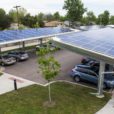The latest Intergovernmental Panel on Climate Change (IPCC) report stresses that our window of opportunity to secure a livable future is rapidly closing, with those most vulnerable to the changing climate being recognized as primarily belonging to low-income communities or racial and ethnic minorities. Across the U.S., Black and Latino populations are frequently identified as being particularly vulnerable to higher temperatures and coastal flooding, succumbing to temperature-related deaths and experiencing loss of labor.
Tackling the climate crisis not only requires a rapid response to keep global warming below the 1.5ºC threshold, but also necessitates the careful protection of vulnerable communities from all environmental hazards through meaningful policy change. It’s imperative that states protect their disadvantaged communities from negative environmental threats, and also integrate them purposefully throughout decision-making processes.
For states looking to make equitable climate progress, a simple, but key first step is to define environmental justice (EJ) communities, and designate where they are. This clears a path towards consistent policy-making for affected groups.
EJ Community Designations
Ultimately, meeting the needs of affected communities is contingent upon clearly and consistently identifying the criteria for communities of concern. EJ community definitions differ across states and entities, but they generally refer to a minority, low-income, tribal, or Indigenous population or geographic location in the U.S. that is disproportionately exposed to environmental hazards and risks.
In designating an EJ community, states must acknowledge the many socioeconomic and environmental factors that disproportionately affect certain groups. This acknowledgement helps pave the way for equitable policymaking, action plans, and working groups focused on promoting EJ principles. It’s important that states establish measurable definitions of what constitutes an EJ community, explicitly describing the methods of quantifying this definition. These may include identifying household income levels, cumulative pollution burden, and English proficiency thresholds.
Model States & Policies
Across the U.S., states are working towards incorporating EJ community designations into environmental policies and climate action plans. They are beginning to understand that environmental hazards burden some communities more than others, and the need for DEIJ (Diversity, Equity, Inclusion, and Justice) principles within the environmental movement. President Biden’s Executive Order, Tackling the Climate Crisis at Home and Abroad, has resulted in momentous EJ initiatives such as the Justice40 Initiative. This initiative requires that 40 percent of the benefits from federal climate, clean energy, and other green investments are delivered to underserved communities. Additionally, the Council on Environmental Quality is developing a Climate & Economic Justice Screening Tool that uses census tract data to aid federal agencies in the identification of disadvantaged communities.
At the state-level, there is significant room to grow in identifying EJ communities. Even states committed to progressive climate action fall short on explicitly recognizing their communities most exposed to environmental hazards. For instance, though the U.S. Climate Alliance is made up of 24 states focused on climate action consistent with Paris Agreement goals, it has only 13 Alliance states that have developed an explicit, measurable definition of an EJ community.
Several of these 13 member states have implemented and introduced model policies and initiatives relating to EJ community designation that other states may look to as they develop their own climate strategies. The following examples are not comprehensive, but provide an overview of ongoing strides by states towards an equitable and sustainable future for all.
New York
New York has included strong EJ initiatives in its Climate Leadership and Community Protection Act of 2019 (CLCPA). The CLCPA sets out to reduce GHG emissions 40 percent by 2030 whilst prioritizing the health and safety of marginalized populations. EJ provisions include a Climate Justice Working Group (CJWG) focused on establishing criteria for identifying disadvantaged communities to achieve GHG emission reductions and regulatory impact statements, among other benefits.
Currently open for public comments, draft indicators for identifying disadvantaged communities are measured broadly by “Environmental Burdens and Climate Change Risks” and “Population Characteristics and Health Vulnerabilities”. The CJWG has identified 45 indicators, including pollution exposure, proximity to environmental hazards, income levels, race and ethnicity, and health outcomes, that will be combined into a holistic score for each census tract in the state. Census tracts that receive a high score, meaning they experience the worst impacts, will be considered disadvantaged communities. Additionally, state investments must be made with the goal of ensuring disadvantaged communities receive at least 35 percent, with a goal of 40 percent, of overall benefits of spending on clean energy and energy efficiency programs.
Massachusetts
Signed last March, Massachusetts’ Act Creating a Next-Generation Roadmap for Massachusetts Climate Policy (Bill S.9), also establishes explicit criteria for defining EJ populations. Based on this criteria, EJ populations include those in which annual median household income does not exceed 65 percent of the statewide annual median household income, 40 percent or more the population is composed of minorities, or at least 25 percent of households lack English language proficiency.
The bill additionally seeks to achieve equitable GHG reductions that protect low-income and EJ populations across Massachusetts, and requires environmental impact reports for projects located near EJ populations that are likely to cause damage. Public participation and greater incorporation of EJ principles in policy making are among other promising provisions in the bill.
Washington
In Washington state, “overburdened community” designations take several socioeconomic and environmental factors into consideration and encompass the definitions of “highly impacted communities” and “vulnerable populations” that are both defined in law. Notably, “highly impacted community” designations are made based on pollution levels drawn from cumulative impact analyses from the Department of Health that demonstrate high impacts of fossil fuel pollution and climate change on communities. “Highly impacted” communities are also those considered to be located in census tracts located on “Indian country”. “Vulnerable populations” are defined as groups that experience a disproportionate risk from environmental factors, meaning residents are at higher risk for poor health outcomes, racial and ethnic minorities, low-income residents, and populations and workers that are exposed to high environmental harms.
Additionally, the Climate Commitment Act (Bill S.5126) establishes a cap-and-invest program for GHGs, and requires analyses of pollution impacts on EJ communities as well as targets and goals to reduce impacts. Furthermore, the bill notes that at least 35 percent of proceeds from the cap-and-invest program must “provide direct and meaningful benefits to vulnerable populations within the boundaries of overburdened communities”.
Other states such as New Jersey and California have explicitly defined EJ communities, and made efforts to achieve statewide environmental justice. As states absorb the findings from the most recent IPCC report and consider how best to protect their vulnerable populations, they can learn from what others are already doing. Climate XChange’s Resource Hub provides information on additional policies relating to Environmental Justice, including the creation of advisory bodies and mapping tools, both of which are crucial in designing effective policies.
Organizations & Additional Resources
Securing a livable future necessitates the protection of all groups, regardless of background, from environmental threats. This, coupled with the integration of underrepresented groups in decision-making processes, ultimately makes for the unified and intersectional environmental movement we desperately need to combat the climate crisis.
The following are a few organizations and resources focused on advancing environmental justice, many of which include additional tools and guides for understanding and achieving EJ within state-specific or community-specific contexts.
State Climate Policy Resource Hub — Our policy pages provide information, resources, and model rules on 50+ state climate policies across seven distinct policy areas. The Climate Governance & Equity page takes a closer look at policies and procedures that address climate and environmental justice. These include action plans, emissions reduction targets, and accountability measures.
We Act for Environmental Justice — focused on building healthy communities and organizing for low-income, people of color impacted by poor environmental health.
Intersectional Environmentalist — community and resource hub centered on dismantling systems of oppression in the environmental movement and amplifying Black, Indigenous, and People of Color (BIPOC) and other underrepresented voices in the environmental space.
Alternatives for Community & Environment — a Massachusetts-based non-profit focused on addressing environmental racism and classism to achieve EJ.
Communities for a Better Environment — EJ organization centered on protecting California’s communities of color and low-income populations from pollution and building sustainable communities.
Deep South Center for Environmental Justice — focused on research, education, and stakeholder engagement for policy change addressing populations affected by pollution and vulnerable to climate change in the Gulf Coast Region.
North Carolina Environmental Justice Network — coalition of North Carolina community organizations focused on promoting EJ through organizing, advocacy, research, and education.









